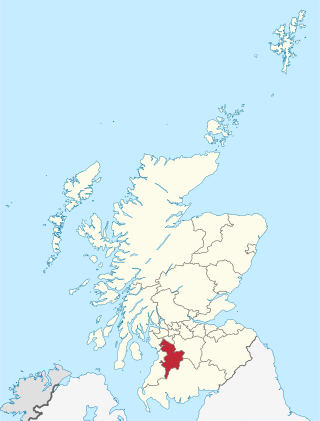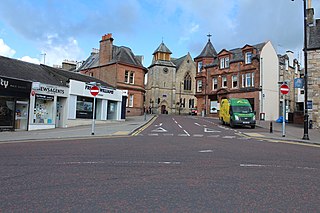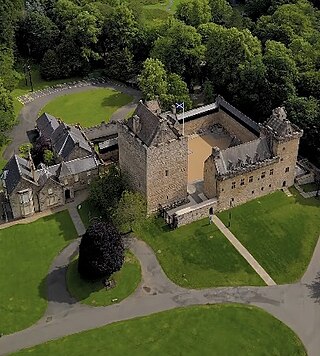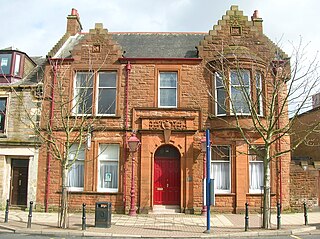
Miffy is a fictional rabbit appearing in a series of picture books drawn and written by Dutch artist Dick Bruna. The original Dutch name, "nijntje", is a shortening of the diminutive konijntje, "little rabbit".

Ayrshire is a historic county and registration county, in south-west Scotland, located on the shores of the Firth of Clyde. The lieutenancy area of Ayrshire and Arran covers the entirety of the historic county as well as the island of Arran, formerly part of the historic county of Buteshire. Its principal towns include Ayr, Kilmarnock and Irvine and it borders the counties of Renfrewshire and Lanarkshire to the north-east, Dumfriesshire to the south-east, and Kirkcudbrightshire and Wigtownshire to the south. Like many other counties of Scotland, it currently has no administrative function, instead being sub-divided into the council areas of East Ayrshire, North Ayrshire and South Ayrshire. It has a population of approximately 366,800.

East Ayrshire is one of 32 unitary council areas of Scotland. It shares borders with Dumfries and Galloway, East Renfrewshire, North Ayrshire, South Ayrshire and South Lanarkshire. The headquarters of the council are located on London Road, Kilmarnock. With South Ayrshire and the mainland areas of North Ayrshire, it formed the former county of Ayrshire.

Kilmarnock is a town and former burgh in East Ayrshire situated in southwest Scotland. The town has served as the administrative centre of East Ayrshire Council since 1996 and is the region's main commercial and industrial centre.

Cumnock is a town and former civil parish located in East Ayrshire, Scotland. The town sits at the confluence of the Glaisnock Water and the Lugar Water. There are three neighbouring housing projects which lie just outside the town boundaries, Craigens, Logan and Netherthird, with the former ironworks settlement of Lugar also just outside the town, contributing to a population of around 13,000 in the immediate locale. A new housing development, Knockroon, was granted planning permission on 9 December 2009 by East Ayrshire Council.

Darvel (Scots: Dairvel, Scottish Gaelic: Darbhail) is a town in East Ayrshire, Scotland. It is at the eastern end of the Irvine Valley and is sometimes referred to as "The Lang Toon".
Christine Borland is a Scottish artist. Born in Darvel, Ayrshire, Scotland, Borland is one of the Young British Artists (YBAs) and was nominated for the Turner Prize in 1997 for her work From Life at Tramway, Glasgow. Borland works and lives in Kilcreggan, Argyll, as a BALTIC Professor at the BxNU Institute of Contemporary Art.

Dean Castle is a 14th century castle located in Kilmarnock, East Ayrshire, Scotland. It was the stronghold for the Boyd Family, who were lords of Kilmarnock for over 400 years, and is situated in a 200-acre (80-hectare) site situated within the Dean Castle Country Park.

Bonnyton is a former village in East Ayrshire which is currently an area in the western part of the town of Kilmarnock in southwest Scotland. It is home to a mix of residential and commercial properties, centred around estates such as Bonnyton Road, Munro Avenue and Gibson Street.
Riccarton is a village and parish in East Ayrshire, Scotland. It lies across the River Irvine from Kilmarnock, this river forming the boundary between Riccarton and Kilmarnock parishes, and also between the historical districts of Kyle and Cunningham. The name is a corruption of 'Richard's town', traditionally said to refer to Richard Wallace, the uncle of Sir William Wallace. The parish also contains the village of Hurlford.

The Burns Monument in Kay Park, Kilmarnock, Scotland, commemorates the poet Robert Burns (1759–1796). It is located at an elevated position within Kay Park, to the east of Kilmarnock Town Centre. The monument was opened in 1879, and is a category B listed building. In 2004, following years of neglect by the local council, fire destroyed most of the building. What was left of the monument was incorporated into the new Burns Monument Centre which opened in 2009. In 2010 the centre was shortlisted for the Carbuncle Cup award run by Building Design.

The Palace Theatre & Grand Hall Complex is a multi-purpose entertainment arena complex in Green Street, Kilmarnock, Scotland. The structure, which was originally opened as a corn exchange, is a Category A listed building.

The Eglinton Trophy or Eglinton Testimonial is a Gothic style Sterling silver centrepiece presented by friends and admirers to the 13th Earl of Eglinton to commemorate the medieval re-enactment known as the Eglinton Tournament held at Eglinton Castle, Kilwinning, North Ayrshire in 1839. At 4 foot 8 inch (140 cm) in height and 1600 ounces (45 kg) in weight it is one of the largest and most extravagant trophies of its kind.

The Irvine Burns Club, based at the Wellwood Burns Centre & Museum, was founded on 2 June 1826 and is one of the world's longest continuously active Burns Clubs. At least five personal friends of Robert Burns were among the group of local gentleman, whose idea it was to form the club. Irvine in North Ayrshire is an old market town and port situated on the west coast of Scotland, approx 14 miles north of Ayr.

Earlston is a hamlet in Riccarton, East Ayrshire, Scotland. The habitation dates from at least the early 18th century and is near Caprington Castle and Todrigs Mill. It was for many years the site of a large sawmill and a mine pumping engine, and had sidings of the Glasgow and South-Western Railway's Fairlie Branch.
What now survives of the old Caprington Loch (NS402352) is situated near Earlston, Riccarton, East Ayrshire, Scotland. The loch was a natural feature, sitting in a hollow on the old Caprington Castle estate. The loch waters drain via the Todrigs Burn that flows into the River Irvine to the east of Gatehead village. It was partly drained, probably sometime after the 1820s, as were so many other lochs, as part of 18th and 19th centuries extensive agricultural improvements and the only area of open water that remains does so as it was once used as a curling pond for the Caprington Castle Estate owners and their employees or tenants.
Shona Kinloch is a Scottish artist based in East Kilbride who specialises in sculpture.

Duncan McNaught LL.D., J.P., was born in Alexandria, Dunbartonshire in 1845. He was the parochial school teacher at Kilmaurs in East Ayrshire from 1867 and served at the school for over fifty years, having served as assistant from 1865. He founded the Kilmarnock Conservative Association, jointly founded the Robert Burns World Federation, acted as the editor of the "Burns Chronicle" and was the president of what became the Robert Burns World Federation.

James M'Kie or James McKie (1816–1891) was an apprentice of Hugh Crawford, John Wilson's successor at the Kilmarnock Cross printing business. In 1867, M'Kie published the first facsimile edition of the 1786 "Kilmarnock Edition" or Poems, Chiefly in the Scottish Dialect as well as various bibliographies, reprints, special editions, limited editions, etc. of Robert Burns' and other works for the Scottish, British, British Empire or North American markets. He became an avid collector of Burnsiana and put together the largest collection of published in the world at the time, that was eventually purchased by the local Kilmarnock Corporation and housed in the Kay Park Burns Museum.

HALO Urban Regeneration, known simply as The HALO, is a Scottish business innovation park, urban regeneration and business start-up support company, founded, based and headquartered in Kilmarnock, East Ayrshire, Scotland. The HALO Urban Regeneration was founded by entrepreneur Marie Macklin CBE in 2006 as HALO Urban Regeneration Company Ltd., having announced the project a few years prior to official funding and creation of the HALO Kilmarnock.



















